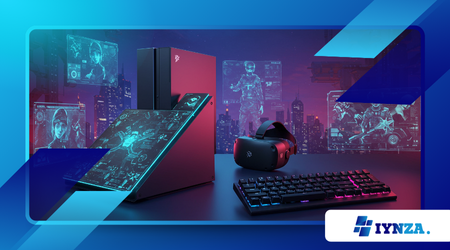Gaming Hardware Innovations: What to Expect from Next-Gen Consoles

Gaming evolves in leaps. Each console generation has brought breakthroughs that once seemed impossible—better graphics, faster loading, and new ways to interact.
Anúncios
As next-gen consoles get closer to release, players are buzzing with anticipation. What changes will shape the future of gameplay? What will the next Xbox, PlayStation, or Switch do differently?
This article explores the upcoming gaming hardware innovations expected in the next generation of consoles. It’s not just about power—it’s about how those innovations change the player experience.
Processing Power and Visual Realism Will Redefine Gameplay
Expect massive leaps in raw performance. Next-gen consoles are rumored to feature custom chips capable of rendering hyper-realistic environments with ray tracing and frame generation techniques. That means reflections in puddles, realistic shadows that react to lighting in real time, and buttery-smooth animations.
Developers will no longer need to scale back environments to maintain performance. That opens space for more interactive worlds, deeper AI behaviors, and seamless transitions between areas—without loading screens.
In competitive titles, higher frame rates will give players a tangible edge. And for story-driven games, more processing power means more believable characters and immersive settings that rival movie productions.
Read also: How Retro Gaming Influences Modern Game Design
AI and Machine Learning Will Make Games Smarter and Faster
Artificial intelligence is entering a new era in gaming. Upcoming consoles are expected to harness AI and machine learning to streamline rendering, upscale visuals, and even predict player behavior.
For example, dynamic resolution scaling powered by AI can ensure a consistent frame rate by adjusting the resolution in real time. NPCs can adapt to your decisions more intelligently. And game engines will start predicting player inputs to reduce latency.
This doesn’t just benefit gameplay. It also means smarter matchmaking, more realistic voice interactions with NPCs, and personalized in-game events. Games will feel less scripted and more alive.
Storage Speed Will Erase Loading Screens for Good
Solid-state drives changed everything in the last generation—but they’re about to get even faster. With next-gen consoles, SSDs could rival the speeds of high-end PC drives, allowing instant loading of textures, animations, and maps.
This shift eliminates traditional bottlenecks. Imagine fast-traveling across massive maps with zero delay. Or entering a complex dungeon in an RPG without a single loading pause. Developers will have freedom to build without technical workarounds.
Expect smarter data compression, better streaming of open-world assets, and a noticeable reduction in memory management issues for players.
Controller Technology Will Deepen Immersion
Controllers will evolve, not just in ergonomics, but in the way they connect you to the game. We’re likely to see expanded use of adaptive triggers, pressure-sensitive buttons, and haptic feedback.
Future hardware could add biometric sensors to track stress levels or heartbeat, adjusting gameplay accordingly. Imagine a horror game responding to your fear, or a racing sim that tightens steering feedback as your pulse rises.
This type of immersion creates a tighter bond between action and reaction, making every input feel more tactile, reactive, and personal.
Backward Compatibility and Game Preservation Will Expand
Gamers are tired of losing access to their libraries. That’s why the next generation is expected to double down on backward compatibility.
PlayStation and Xbox already support some past-gen titles, but upcoming consoles will likely go further, offering smoother emulation, visual upgrades, and cross-generation cloud saves.
This commitment to preservation means players can keep their progress, revisit old favorites, and discover classics without buying new hardware or subscriptions. It builds long-term loyalty and honors the games that shaped the industry.
Cloud Gaming Will Be Built Into the Console Ecosystem
Streaming is no longer just a trend—it’s becoming a standard. Xbox Cloud Gaming and PlayStation’s streaming initiatives are expected to be deeply integrated into next-gen consoles.
This means instant access to new games without downloads, cloud-synced saves, and the ability to jump between devices. You could start a game on your console, continue on your phone, and finish on a smart TV—all seamlessly.
Cloud infrastructure improvements will reduce lag and improve streaming quality, bringing console-grade experiences to more people with fewer barriers.
Console Design Is Shifting Toward Ecosystems, Not Just Hardware
In 2024, over 61% of gamers aged 16–34 reported using cloud gaming at least once a month, according to a Statista consumer insights survey. That’s a massive jump from 29% in 2020.
This data shows a clear trend: players want more flexibility. And next-gen consoles are being built to deliver that. They’re no longer isolated machines that only run physical games. They’re turning into hybrid platforms—part console, part streaming hub, part archive of digital entertainment.
Instead of buying a device for what it can do out of the box, you’re buying into an experience that’s always evolving.
Game subscriptions, cloud features, backward compatibility, AI enhancements—everything is interconnected.
What you’re really purchasing is access: to faster load times, deeper stories, smarter worlds, and a network of services that elevate how and where you play. This is the future of console gaming—not in specs alone, but in seamless integration across devices and platforms.
The Next Console Isn’t Just a Machine—It’s a Portal
Imagine the next-gen console not as a static gaming device, but as a multi-functional gateway.
One part powerhouse capable of high-end visuals and performance., part cloud interface that lets you stream titles on demand and digital museum where your library—old and new—lives forever.
You won’t just boot up games. You’ll access ecosystems. Jump from campaign to community, from couch co-op to mobile continuation. The hardware may sit in your living room, but what it connects you to will reach far beyond.
This shift in design philosophy puts the user at the center—not the tech. It’s about control, convenience, and continuity. And it’s why indie titles, live-service games, and massive open-worlds all thrive on this architecture.
What makes the next console worth it isn’t just the specs—it’s the system it opens up.
What This Means for Gamers Worldwide
If you’re unsure whether waiting for the next console is the right move, consider what’s really changing. It’s not just faster chips or more pixels. It’s the ability to play how you want, when you want, without compromises.
Innovation in gaming hardware isn’t about tech for tech’s sake. It’s about giving players tools to explore, compete, share, and feel more immersed than ever before.
The real power of the next generation will be emotional: more excitement, more connection, more freedom. And that’s something worth looking forward to.
FAQ
1. Will next-gen consoles require new TVs to see the improvements?
Not necessarily. While features like 4K 120Hz displays will enhance the experience, most improvements are still noticeable on standard HD displays.
2. Are all next-gen games expected to support ray tracing?
No. Ray tracing is demanding, so some games may offer it as an optional feature or use it selectively.
3. How will console prices compare to current models?
Analysts suggest prices may start slightly higher, but competition should keep them within the $500–$600 range.
4. Will physical games be phased out?
Not immediately. Digital and cloud gaming will expand, but physical copies will still be supported for now.
5. Do next-gen consoles improve online multiplayer?
Yes. Expect better netcode, dedicated servers, and lower latency across competitive titles.
